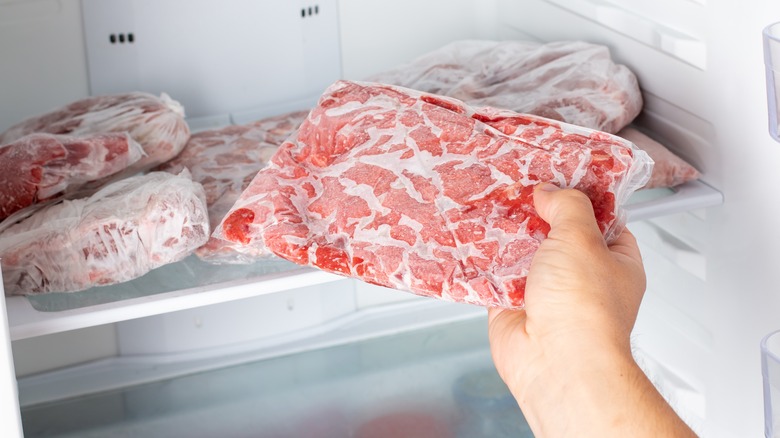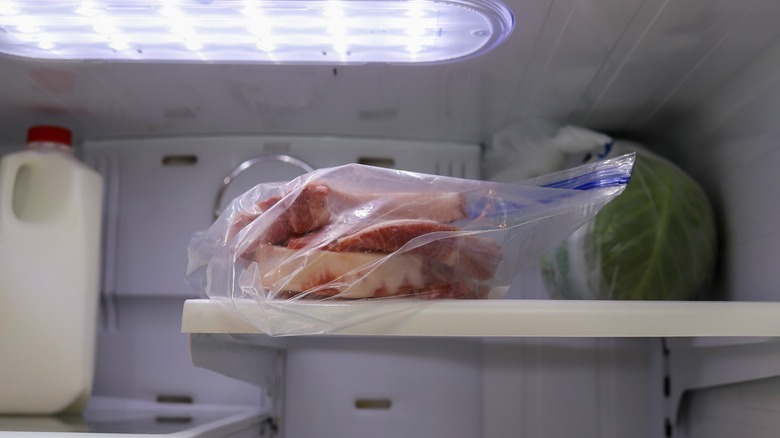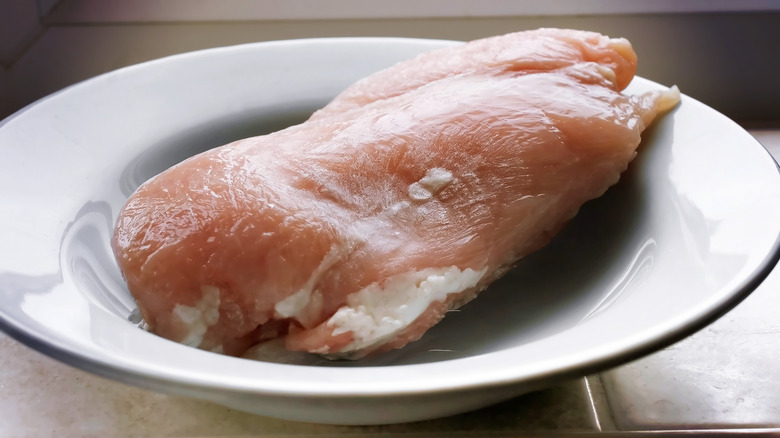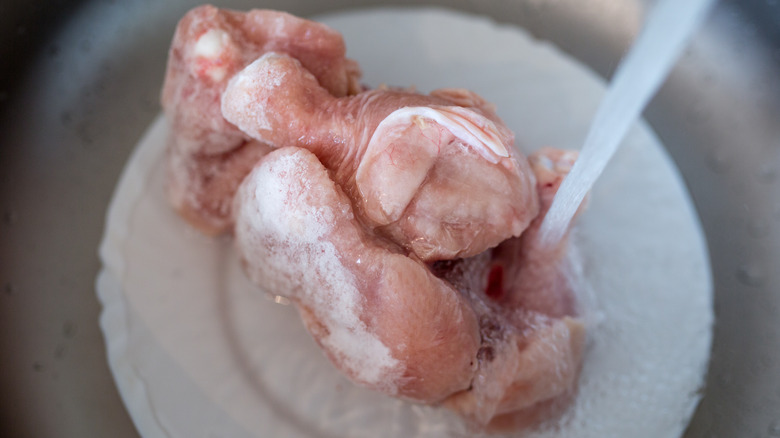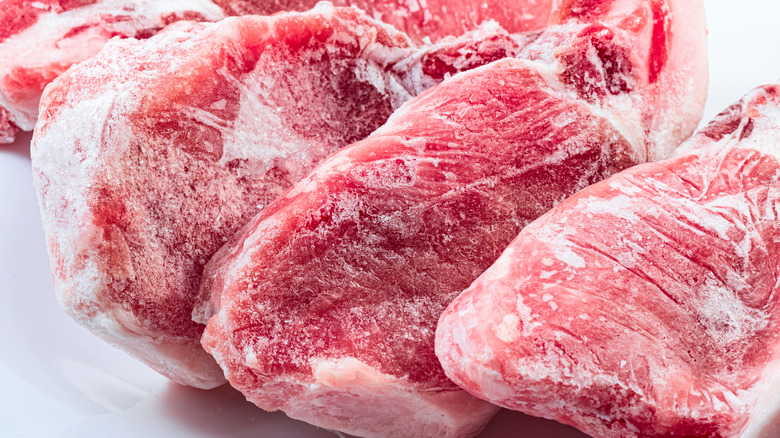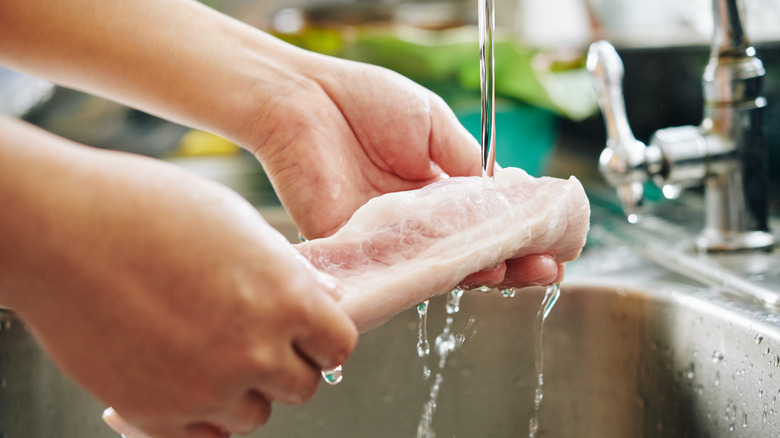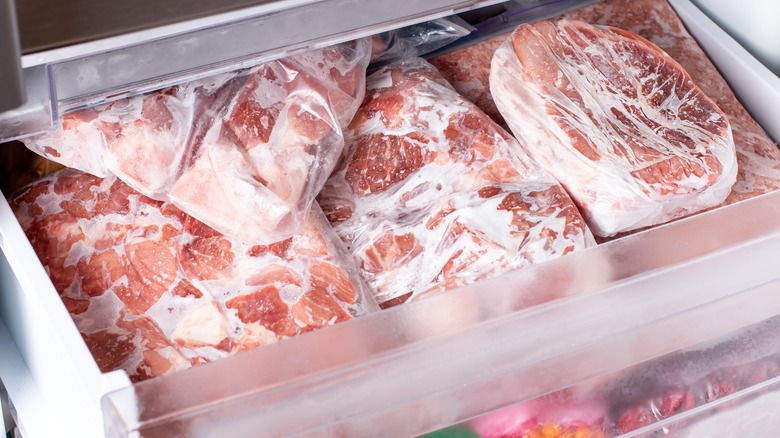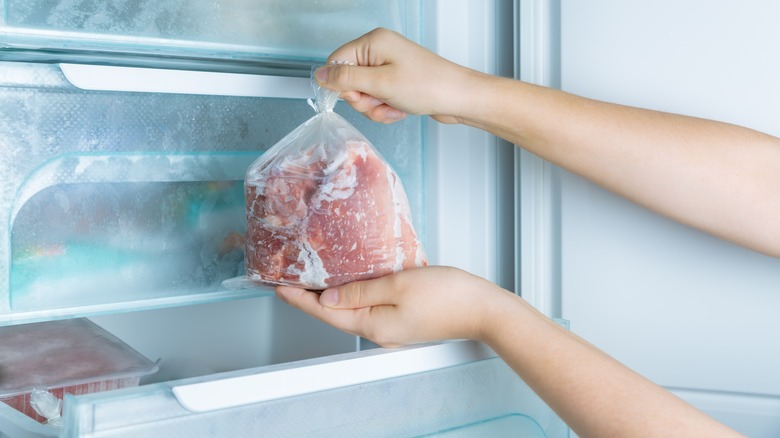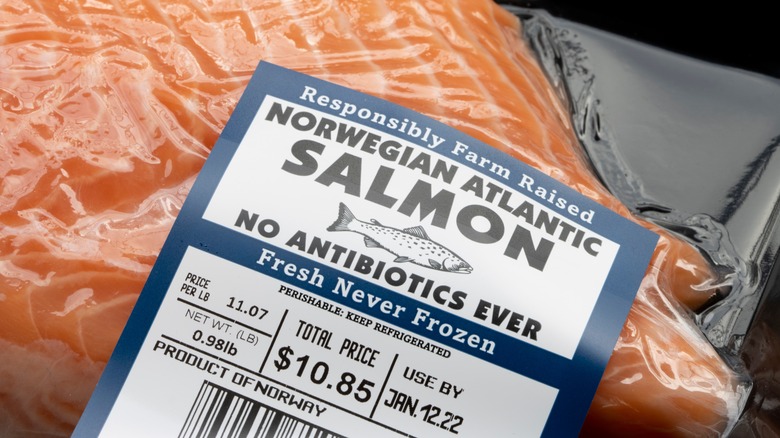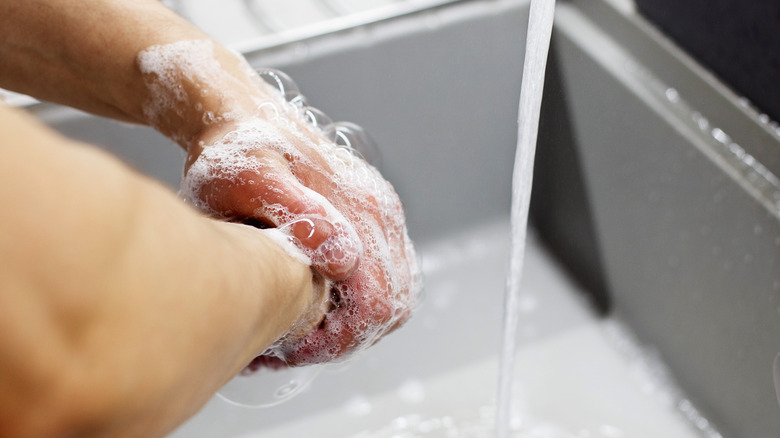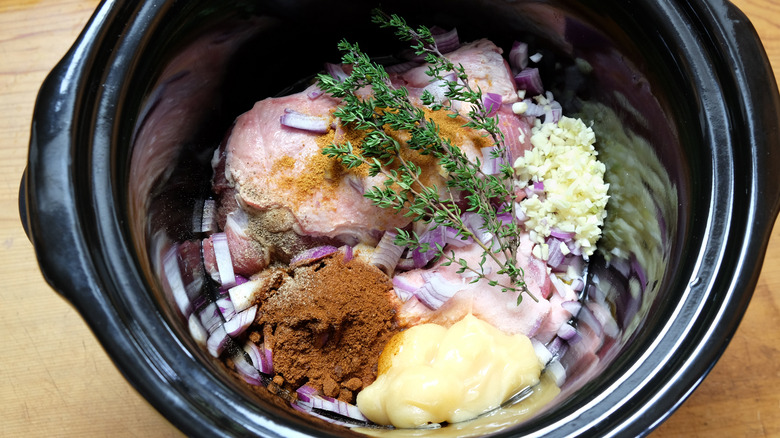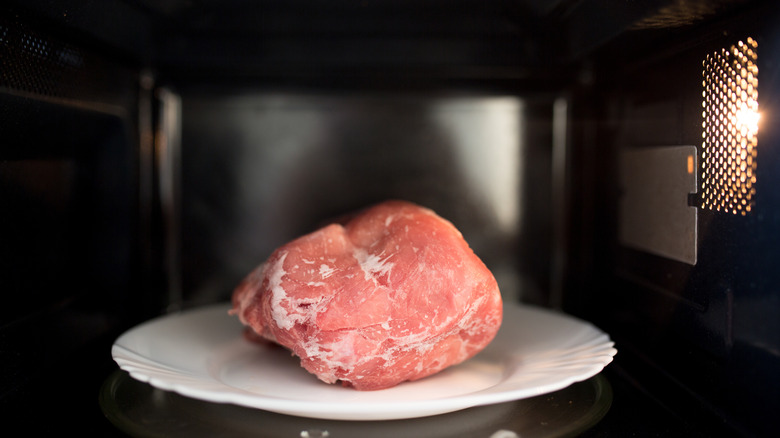The Biggest Mistakes People Make When Defrosting Meat
Thawing frozen meat can spoil your plans for a quick and easy meal. Depending on the protein, it can take as much as a full day to thaw completely. And if you forget to take it out of the freezer in advance, you may find yourself scrambling at the last minute to defrost using a variety of unsafe methods.
We've heard dozens of tips and tricks to thaw meat quickly. From using the microwave to rinsing with hot water to tossing an ice-cold brick of ground beef straight into a hot pan. Rushing the process can promote bacteria growth, putting you at risk for food poisoning and cross-contamination of other foods and kitchen utensils.
Even if you're in a hurry to get dinner on the table, don't fall victim to these common mistakes people make when defrosting meat. There are several safe ways to unfreeze safely, and we recommend taking every precaution to avoid getting sick.
Defrosting on the top shelf
If you already know that thawing in the refrigerator is the safest defrosting method, congratulations. You are absolutely correct. Taking beef, pork, or poultry directly from the freezer and placing it in the refrigerator is the safest way to warm up without the risk of illness.
However, there are some tips to ensure you're thawing correctly. You never want to place protein, especially chicken, on the top shelf to defrost. Placing meat on the top shelf runs the risk of uncooked juices dripping onto other areas of your fridge. According to the Minnesota Department of Health, when those juices come into contact with other foods, you risk cross-contamination from bacteria.
The best place to warm up the protein in your refrigerator is on the bottom shelf. A recommended method for thawing meat in the refrigerator that makes it even safer is using a rimmed plate, jelly roll pan, or baking sheet. The walled edges are ideal for catching any drippings that may leak, stopping them from contaminating your refrigerator.
Defrosting on the counter at room temperature
When preparing your favorite chicken recipe, it may be tempting to place the icy chicken on the counter to defrost all day while you're working. But you should never thaw chicken on the counter. Leaving beef, pork, or poultry at room temperature allows for Clostridium perfringens bacteria, or C. perfringens, to grow and multiply (via CDC). C. perfringens is one of the most common causes of food poisoning in the US. According to CDC estimates, these bacteria can be found on raw meat and poultry and cause 1 million food-related illnesses yearly.
The National Agriculture Library recommends never leaving food outside of the refrigerator for more than two hours. The two-hour limit is not enough time to unfreeze most chicken, pork, or beef, so it's never a good idea to use this method for defrosting meat. Instead, always thaw slowly in the refrigerator. This allows the meat to come to a safe cooking temperature without causing a potential threat.
Submerging meat in hot water
Using hot water to defrost beef or chicken might sound like a quick and easy way to remove all signs of being frozen, but it is not a safe option. This method can cause certain areas of the protein to reach what the Food Safety Inspection Service (FSIS) calls the "Danger Zone." Food is in the danger zone when it reaches 40 F to 140 F. Foods within the danger zone are breeding grounds for bacteria to grow and multiply swiftly.
A safer way to warm up any meat using water is to submerge it in cold water. It will soften the chicken, beef, or pork without bringing it to dangerous temperatures. To ensure safe temperatures, you will need to change out the water frequently. The FSIS recommends changing the water about every 30 minutes to prevent the protein from becoming too warm and reaching the unsafe danger zone.
Cooking without thawing
If you're in a pinch, you might be inclined to toss a brick of ice-covered ground beef straight into a hot pan. Not only is this an ideal condition for bacteria to thrive, but it can also affect the flavor of your final product. The reason you shouldn't cook frozen ground beef, or other protein for that matter, has less to do with bacteria than it does with your food's taste. Cooking meat from frozen can negatively affect the flavor and texture. While in the freezer, the juices freeze into ice crystals, and when you get those into a hot pan, you risk the fluids evaporating and losing some of the great flavors.
If you absolutely must cook from frozen, plan accordingly. The FSIS states that while you can cook ice-cold food, it will take about one and a half times longer to cook to safe temperatures. This means you will likely lose some juiciness, so it certainly isn't the best method to preserve flavor. To ensure your favorite protein is safe to eat and as tasteful as possible, cook it until it stays at its safe temperature for a minimum of two minutes. For a steak that is 145 F, ground proteins need to reach 160 F, and for chicken must be 165 F (via FoodSafety.gov). Ensuring safe internal temperatures for all foods is a big reason you need a meat thermometer.
Rinsing frozen meat before cooking
While submerging icy food in cold water to thaw can be a safe option, rinsing protein in the sink to defrost is definitely not. According to the CDC, washing or rinsing chicken or other raw protein can increase the risks of cross-contamination. This means that washing chicken before cooking it is a bad idea, especially if frozen because the bacteria is more likely to reach other surfaces like your sink, countertops, or other utensils.
Salmonella, C. perfringens, and campylobacter bacteria, which all are causes of food poisoning, are possible risks when handling or consuming raw or undercooked chicken, per the CDC. The same is true for other proteins like beef or pork. Rinsing can spread invisible bacteria to unknown parts of your kitchen, making it nearly impossible to clean properly. To avoid cross-contamination throughout your kitchen, the safest bet is to avoid rinsing or washing your frozen, or even thawed, protein entirely.
Refreezing thawed meat
For beef or poultry that has already been unfrozen and defrosted, refreezing could be a potential food danger. If you've used the microwave or a water bath, you should never put the food back in the freezer to save for a later date. There is too high a risk that you've already hit the danger zone of 40 F or above. Your best bet is to cook to a safe temperature and then store it in the refrigerator.
If you've defrosted the protein safely in the refrigerator and know that it has never even come close to room temperature, then it is safe to refreeze protein that has been thawed. After thawing in the refrigerator, you have about three days to get the protein back in the freezer without risking bacteria or spoilage (via Healthline).
What about refreezing beef, pork, or poultry that has been unfrozen and then cooked? It is possible if you do it safely. If you previously thawed safely in the refrigerator, cooked the meat to the required internal temperature, and the cooked protein sat at room temperature for less than two hours, you can safely refreeze it. Be sure to follow these same instructions the next time you reheat it, though. And we recommend not refreezing it a second time. The quality of the food will suffer.
Storing improperly
While the University of Illinois does state that you can safely freeze food in its original packaging, they also remind us that this packaging often allows air to penetrate, causing freezer burn and loss of quality and freezer burn. This is especially true when you purchase protein that has a single layer of plastic wrap. If it comes vacuumed sealed, you can absolutely pop it in the freezer as is.
If the package is not vacuum sealed, removing as much air as possible is best. Zip top bags are great for freezing your ground beef, pork, chicken, steak, and more. Not only do they stop air from permeating and reduce the risk of quality and flavor loss, but they also are more likely to prevent leaked juices and cross-contamination than using plastic wrap.
Another safe option is to store meat in freezer paper by wrapping it tightly before stashing it in the ice box. Remove from the original packaging and individually wrap pieces. This paper is designed with a plastic coating on the inside to keep juices in and protect from freezer burn. Be sure to cover the beef, pork, or poultry tightly and to thaw on a rimmed plate or dish to avoid any leaking fluids or spreading of bacteria.
Not paying attention to packaging dates
Most packaged fresh foods, especially meat, have a best-by or use or freeze-by date on them. These dates, according to the FSIS, are to ensure peak freshness and quality of the food. However, the labeled dates are not an indicator of food safety but instead are there to help ensure the best flavor. Follow these dated guidelines regarding the maximum time food can hang out in the fridge without losing its taste. But once a protein is placed in the freezer at 0 F, these dates become obsolete.
So does that mean you can safely eat two-year-old frozen meat? No, unfortunately not. Frozen beef, pork, or poultry of any kind has a freezer shelf life of a year at most. While it is not necessarily a safety concern to eat meat that's been in the freezer for over 12 months, the quality degrades significantly the longer it is in the freezer. You'll lose color, texture, and flavor.
A great tip is always to date the foods you place in the freezer. Whether you use zip-top bags or freezer paper, use a marker to stamp the date you popped it in to freeze. Then rotate any new beef, pork, or poultry added to your freezer, placing more recent packages further back and pulling older ones forward to be used first.
Not cleaning properly
In a September 2020 study about frozen food safety, the USDA found that 97% of participants did not wash their hands before food prep, and 95% who did wash their hands did not wash them properly while handling ice-cold foods (via Food Safety News). This is particularly dangerous when handling raw meat. Animal proteins are at the highest risk of contamination and are more likely to get you sick (via CDC).
It is easy to assume that handling beef, pork, or poultry from the freezer is somehow safer than handling it raw because while ice-cold, no juices are dripping anywhere. But that is not the case, and contamination is still a gamble. When thawing, wash your hands whenever you come in contact with frozen, partially unfrozen, or fully thawed meat. FoodSafety.gov recommends that you wash your hands before and after handling any frozen or defrosted food. For icy and uncooked proteins, they also recommend you wash cutting boards, utensils and countertops with hot soapy water after any contact. Dish towels and rags should also be cleaned using the hot cycle in your washing machine.
Slow cooking frozen meat
Some crockpot recipes claim that you can throw frozen beef, pork, or poultry in a slow cooker for quick and easy weeknight dinners. In fact, many out there believe that this is one of the absolute best uses for your slow cooker. But we strongly urge you to reconsider that unsafe advice. Since slow cooking is so well ... slow, it can create prime ground for bacteria growth. As the slow cooker does its thing, the uncooked meat can stay at hazardous temperatures for far too long, creating the perfect environment for unwanted and dangerous bacteria to multiply.
The USDA recommends always thawing your beef, pork, or poultry before using it in your favorite slow cooker recipe. In this case, we'd recommend skipping the microwave method for unfreezing since you won't be bringing the meat to a safe temperature immediately. Warm up the protein safely overnight in the refrigerator or in a cold water bath for up to two hours before cooking it in the slow cooker to avoid any risks of hitting the danger zone. Then, try out something delicious, such as this easy Crockpot sesame chicken recipe
Using the microwave
The microwave might seem like a quick option for thawing quickly when you're in a hurry. Most microwaves even come with a handy defrost button. But in all honesty, you should reconsider using the defrost button on your microwave. It does not heat evenly and can quickly bring parts of your frozen beef or poultry up to perilous temperatures and into the dreaded danger zone. If you're in a pinch, you can thaw using the microwave, but you absolutely must cook the protein to a safe internal temperature immediately after unfreezing it.
And when it comes to particularly good pieces of meat, in particular, using the microwave is the defrosting mistake that Gordon Ramsay says will make steaks chewy. You should never use the microwave, on any setting, to unfreeze a steak, even if you're in a time crunch. Microwaving a steak can not only increase the risk of food illnesses, but it can also cause discoloration and a rubbery texture. Your best bet is always to thaw your steaks in the refrigerator. Since it's expected that food prices will remain high even as inflation slows, there's no room to be turning your groceries into anything other than the best-tasting food possible.
